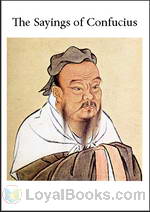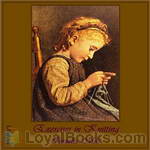|
Books Should Be Free Loyal Books Free Public Domain Audiobooks & eBook Downloads |
|
|
Books Should Be Free Loyal Books Free Public Domain Audiobooks & eBook Downloads |
|
Top Authors |
|---|
|
Book type:
Sort by:
|
By: Confucius (551-479 BC) | |
|---|---|
 The Sayings of Confucius
The Sayings of Confucius
A treasure trove of wise and pithy sayings, reflections on education, family values, the ideal human being, life and living, politics, art, culture and timeless wisdom, The Sayings of Confucius is indeed an invaluable addition to your bookshelf. Ever since Chinese literary works first began to be translated into European languages, the works of the legendary Chinese philosopher and teacher Confucius, who lived in present day Qufu in the Shandong province of China, more than two thousand years ago, have held universal appeal... | |
 Confucian Analects
Confucian Analects
The Analects, or Lunyu (simplified Chinese: 论语; traditional Chinese: 論語; pinyin: Lún Yǔ; literally "Classified/Ordered Sayings"), also known as the Analects of Confucius, are considered a record of the words and acts of the central Chinese thinker and philosopher Confucius and his disciples, as well as the discussions they held. Written during the Spring and Autumn Period through the Warring States Period (ca. 475 BC - 221 BC), the Analects is the representative work of Confucianism and continues to have a substantial influence on Chinese and East Asian thought and values today... | |
By: Coningsby Dawson (1883-1959) | |
|---|---|
 It Might Have Happened to You
It Might Have Happened to You
This is a frank eyewitness description of the suffering, starvation in particular, that was widely experienced in Central and Eastern Europe in the aftermath of "The Great War". “It is not stating matters too strongly to say that…peace had caused at least as much misery as the four years’ fury of embattled armies.” It is a powerful political and anti-war statement with scant mention of any battle. – Lee Smalley | |
By: Conrad Aiken (1889-1973) | |
|---|---|
 House of Dust: A Symphony
House of Dust: A Symphony
The House of Dust is a poem written in the four-movement format of a classical symphony. Hauntingly beautiful despite its bleak post-World War I depictions of human mortality and loss, the poem develops its movements around central images such as Japanese ukiyo-e ("floating world") woodblock prints, touching the reader's senses with endlessly evocative allusions to wind, sea, and weather. In this underlying Japanese sensibility and dependence on central perceptual images, Aiken's poem is similar to poetry of Imagists of the time such as Amy Lowell. Also deeply influenced by the concepts of modern psychology, Aiken delved deeply into individual human identity and emotion. | |
 Nocturne of Remembered Spring, and Other Poems
Nocturne of Remembered Spring, and Other Poems
Written at the height of the Great War, the poems of this volume are suffused with a sense of melancholy and tragedy. Some of the poems (such as "1915: The Trenches") speak directly of war-time scenes and images, but even those which don't do so are permeated with a feeling of loss and desolation occasioned by the War. In spite of this pervading pathos, however, these poems are also filled with haunting beauty of imagery, drawn as Aiken so often does from natural images of wind, sea, and weather. | |
By: Constance Cary Harrison (1843-1920) | |
|---|---|
 The Old-Fashioned Fairy Book
The Old-Fashioned Fairy Book
"And now, mamma, until your tea is ready, we know what you must do," said the children, in a breath. "Tell us a story—a 'real, truly' fairy tale, about a giant and a dwarf, lots and lots of fairies, a prince and a beautiful princess with hair to her very feet, a champion with a magic sword, a dragon-chariot, a witch dressed in snake-skin—and, if you can, an ogre. Don't punish anybody but the witch and the ogre; and please don't have any moral, only let everybody 'live in peace and die in a pot of grease,' at the end of it... | |
By: Constance Elizabeth Maud (1857-1929) | |
|---|---|
 No Surrender
No Surrender
Written from the midst of the struggle for female suffrage, Constance Elizabeth Maud’s novel No Surrender (1911) is a Call to Arms. It is a dramatic narrative portraying key players and historical events in the battle for the Vote for Women in Britain. Jenny Clegg is a Lancashire millgirl working long, hard hours under unhealthy conditions in order to support her mother and younger siblings, only to have her father take possession of her savings. In order to seek the rights to improved work conditions, equal pay, and many other human rights, she joins the movement of women seeking political representation... | |
By: Constance Johnson | |
|---|---|
 When Mother Lets Us Cook
When Mother Lets Us Cook
A book of simple receipts for little folk with important cooking rules in rhyme together with handy lists of the materials and utensils needed for the preparation of each dish. | |
By: Constance Lytton (1869-1923) | |
|---|---|
 Prison & Prisoners: Some Personal Experiences
Prison & Prisoners: Some Personal Experiences
Constance Lytton worked along Emmeline Pankhurst for the cause of women's suffrage in England. Upset that she was getting preferential treatment by the authorities, she assumed a pseudonym so that her titled status wouldn't be obvious. This book chronicles her involvement in the suffrage movement, including her arrest and subsequent incarceration at Holloway Prison, a place notorious for the poor treatment of the women in their charge. - Summary by KHand | |
By: Constance Naden (1858-1889) | |
|---|---|
 Sonnets
Sonnets
Naden's sonnets have topics as diverse as astronomy, classical mythology and Shakespeare's birthplace. This collection is taken from Naden's complete poems, and whether listeners enjoy French history or the natural world, there are subjects to appeal to all tastes.- Summary by Newgatenovelist | |
By: Constantine Panunzio (1884-1964) | |
|---|---|
 Deportation Cases of 1919-1920
Deportation Cases of 1919-1920
"The study here presented embodies the findings of an investigation into the recent [1919-1920] deportations of persons deemed to be unlawfully in the country. . . Its purpose is to call public attention to practices that are inconsistent with the American tradition of justice and fair-play." | |
 Soul of an Immigrant
Soul of an Immigrant
Constantine Panunzio begins his autobiography by describing his childhood in Molfetta, Italy. At age 13, he left home as a sailor, landing in Boston in 1902. His trials finding work, learning English, and securing an education in the U.S. were many, but eventually, he became administrator of a social service agency in Boston. During WWI, he served as head of the YMCA on the Italian front. Concerned throughout his career with the treatment and assimilation of immigrants, Panuncio criticized the post world War I hysteria about alien radicals in his book The Deportation Cases of 1919-1920. - Summary by Sue Anderson | |
By: Cordelia Ray (1852-1916) | |
|---|---|
 Sonnets
Sonnets
Cordelia Ray was a Black author and teacher. This volume contains 12 of her poems and was first published in 1893. - Summary by Newgatenovelist | |
By: Cordwainer Smith (1913-1966) | |
|---|---|
 Psychological Warfare
Psychological Warfare
Psychological warfare and propaganda have been used extensively in warfare since the earliest times. This book explores the functions, limitations, types, and history of psychological warfare through 1953. It was written by Paul Myron Anthony Linebarger, a US Army officer, a noted East Asia scholar, and an expert in psychological warfare, also known by the pseudonym Cordwainer Smith as a science fiction author. Linebarger had extensive experience with the practice and implementation of psychological warfare techniques in the field through his work with the Office of War Information, the Operation Planning and Intelligence Board, and the CIA... | |
By: Cornelia Mee | |
|---|---|
 Exercises in Knitting
Exercises in Knitting
Mrs. Mee, her husband, and her sister ran a yarn and needlework import/warehouse business in Bath, England. Her books primarily contain practical everyday items that knit up quickly with the busy homemaker in mind. At this time, published knitting “receipts” did not contain abbreviations and were laborious to use. They were, however, rich in error! Later in her career, due to circumstances of war and the resulting social stress and poverty, many of her knitting books were printed for ladies’ charitable societies, which used her knitting “receipts” to clothe the poor mill workers who were out of work due to the American Civil War and the embargo of cotton. | |
By: Cornelia Meigs (1884-1973) | |
|---|---|
 The Windy Hill
The Windy Hill
When two children come to stay with their cousin, they immediately realize something is wrong, but no one will tell them what. Their cousin is strangely altered: nervous, preoccupied, hardly aware of their existence. They soon discover that a conflict is brewing among the hills and farms of the Medford Valley, one whose origins reach back over a century. They must piece it together from scattered clues, and from the stories told to them by a mysterious bee keeper and his daughter. This 1922 Newbery Honor Book tells of the traits that run in a family—honor, stubborn pride, and a dark lust for wealth—and how they shape the destinies of three generations. (Introduction by Peter Eastman) | |
 Island of Appledore
Island of Appledore
Any one who knows the coast of New England will know also the Island of Appledore and just where it lies. Such a person can tell you that it is not exactly the place described in this book, that it is small and bare and rocky with no woods, no meadows, no church, or mill, or mill-creek road. Perhaps all that the story tells of it that is true is that there the rocks give forth their strange deep song, “the calling of Appledore,” as warning of a storm, that there the poppies bloom as nowhere else... | |
By: Cornelia Stratton Parker (1885-?) | |
|---|---|
 American Idyll: The Life of Carlton H. Parker
American Idyll: The Life of Carlton H. Parker
In a memoir marked by joy, love, and an unbending sense of adventure, Cornelia Stratton Parker reveals the heart of a unique man and their life together. As a member of California's turn-of-the-20th-century Immigration and Housing Commission, Carlton H. Parker came to understand the problems surrounding migrant camps and the labor movement in general. In this volume she recounts his undertakings in that regard and their family life. | |
By: Cornelius à Lapide (1567-1637) | |
|---|---|
 Great Commentary of Cornelius à Lapide (St. Matthew's Gospel Chaps I - IV)
Great Commentary of Cornelius à Lapide (St. Matthew's Gospel Chaps I - IV)
Cornelius Cornelii a Lapide was born in Belgium. He became a priest in 1595 and taught philosophy, and Hebrew, while also preaching and administering the Sacraments. In 1616 he was moved to Rome in the same capacity. Towards the end of his life, he devoted himself exclusively to completing and correcting his commentaries, which covered almost every part of the Bible. The commentaries show a mastery of Hebrew, Greek, Latin, Syriac and Arabic, in addition to a familiarity with the church fathers. His Latin commentaries stretched over 30 volumes and were the standard Catholic texts for understanding any part of scripture, until more modern times. - Summary by ancientchristian | |
By: Coulson Kernahan (1858-1943) | |
|---|---|
 Visions
Visions
Deeper questions of life and death, and of God’s relationship to man, are explored in this collection of “dreams” by a noted English novelist and literary critic. A man takes an uncertain step into the next world as his life ends – Defendants at the Last Judgment hurl their own accusations at the Judge – An angel arrives on Christmas Eve to guide one soul through a night of despair and doubt – Flowers in a garden contemplate their own mortality – What would it mean if the world renounced Christ, or God took Christ away from the world? – And in a world of the future, pleasure and luxury are pursued … and children are nowhere to be found. (Introduction by D. Leeson) | |
By: Countee Cullen (1903-1946) | |
|---|---|
 Color
Color
Countee Cullen’s poetry in Color contemplates Black Americans’ fractured sense of self—at once spiritually tied to homelands where their ancestors were kidnapped and rooted in the white supremacist society where they live. With poems about love, tradition, the intertwined lives of Black people and whites, and the experience of a "Negro in a day like this," Color is a profound early work of the Harlem Renaissance. The collection’s most famous poem is "Heritage". | |
By: Countess Evelyn Martinengo-Cesaresco (1852-1931) | |
|---|---|
 Cavour
Cavour
Camillo Benso, Count of Cavour was an Italian statesman and a leading figure in the movement for Italian unification. A nobleman born in Turin, Cavour founded the political newspaper "Il Risorgimento." An ardent admirer of Britain's constitution monarchy, with whose statesmen he forged strong diplomatic ties, he rose to become prime minister of Piedmont-Sardinia under King Victor Emmanuel II. By skillful maneuvering, Cavour enlisted the military support of Emperor Napoleon III of France in freeing the Italian states from Austrian tyranny, and in an uneasy alliance with the military leader Giuseppe Garibaldi, he forged the modern Italian state. - Summary by Pamela Nagami, M.D. | |
By: Coventry Patmore (1823-1896) | |
|---|---|
 Revelation
Revelation
Coventry Kersey Dighton Patmore was an English poet and critic best known for The Angel in the House, his narrative poem about an ideal happy marriage. | |
By: Covington Clarke | |
|---|---|
 Aces Up
Aces Up
A crack American flying troop has been sent to France, where they await further instructions. They are concerned that their extensive talents will not be put to good use in the war. Major Cowan introduces Lt. McGee as the British instructor for the crew. It turns out the Brit is actually an American, born in the U.S., even though his parents were British. McGee and Larkin are flying partners. Out on a mission, McGee spots a small enemy plane in a searchlight, probably intent on dropping flares to mark targets for bombers... | |
By: Curtis D. Wilbur (1867-1954) | |
|---|---|
 Bear Family at Home
Bear Family at Home
THE BEAR FAMILY AT HOME -And How the Circus Came to Visit Them Once a little cub bear was caught in a big log trap, and taken on a train to a circus. He lived in the circus a long, long while, and every day a great many people came to see the bear, and the lions, and the tigers, and the leopards, and the elephants, and the camels, and the other animals. Every night the animals would all be put in the wagons made for them, then the wagons would be rolled on the flat-cars of a railroad train. The train would go all night to another town, where a great many people would come to see the animals and the men and women in the circus... | |
By: Cuthbert Wright (1899?-1948) | |
|---|---|
 Eight Harvard Poets
Eight Harvard Poets
"I will wade out till my thighs are steeped in burn- ing flowers I will take the sun in my mouth and leap into the ripe air Alive with closed eyes to dash against darkness in the sleeping curves of my body Shall enter fingers of smooth mastery with chasteness of sea-girls Will I complete the mystery of my flesh I will rise After a thousand years lipping flowers And set my teeth in the silver of the moon." -- E. Estlin Cummings in Crepuscule Eight Harvard Poets is a anthology of poetry by E. Estlin Cummings, S. Foster Damon, J. R. Dos Passos, Robert Hillyer, R. S. Mitchell, William A. Norris, Dudley Poole, and Cuthbert Wright. These older poems remain inspiring and timeless. | |
By: Cyrano de Bergerac (1619-1655) | |
|---|---|
 Voyage to the Moon
Voyage to the Moon
This is an edition by Professor Curtis Page of the Lovell translation of a seminal work of science fiction by Cyrano de Bergerac. Arguably a whimsical forerunner to the adventure stories of Jules Verne, and the French sci-fi tradition generally, it is a utopian novel of space travel complete with rocket powered flight and extra-terrestrial beings. | |
By: Cyril of Alexandria (376-444) | |
|---|---|
 That Christ Is One
That Christ Is One
Cyril of Alexandria was the leading voice of Nicene orthodoxy in the Christological controversies between Constantinople (381) and Chalcedon (451). Assuming the mantle of the Cappadotian fathers, he answered the auguments of Nestorius who had changed the liturgy of Constantinople by altering the prayer which referred to Mary as the Mother of God. Although he died seven years before the Council of Chalcedon, his writings and formulations heavily influenced not only Chalcedon, but the entire trajectory of orthodox christological thought. | |
 Commentary on the Gospel of John, Book 12
Commentary on the Gospel of John, Book 12
Book 12 of Commentary on St John's Gospel covers John 18:24-21:25. | |
 Commentary on the Gospel of Luke, Sermons 1-11
Commentary on the Gospel of Luke, Sermons 1-11
Sermons 1-11 cover the Gospel of St Luke 1:1 - 3:23. - Summary by the Reader | |
 Commentary on the Gospel of Luke, Sermons 12-25
Commentary on the Gospel of Luke, Sermons 12-25
Sermons 12-25 cover the Gospel of St Luke 4:1 - 6:17. - Summary by the Reader | |
 Commentary on the Gospel of Luke, Sermons 27-38
Commentary on the Gospel of Luke, Sermons 27-38
Sermons 27 through 38 cover the Gospel of St Luke 6:20 - 7:28. - Summary by the Reader | |